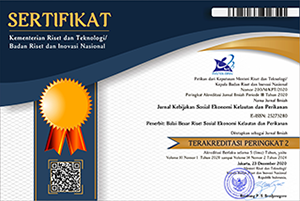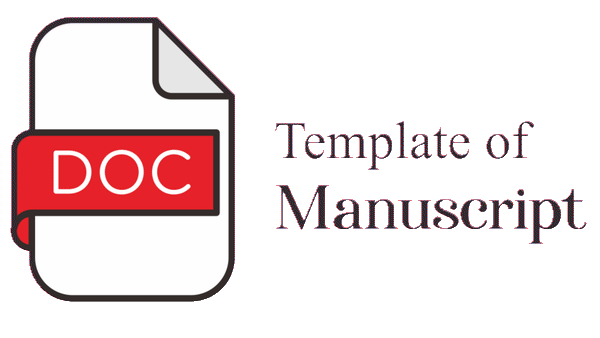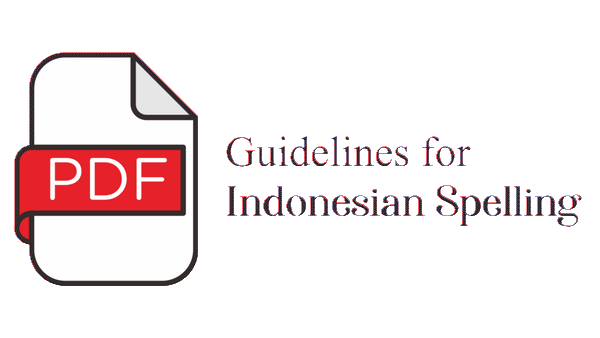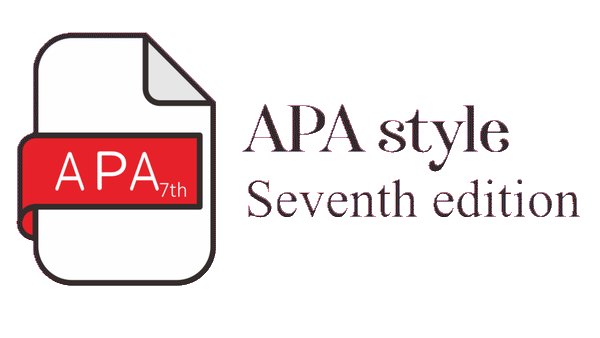Proteksionisme dan Standardisasi Garam Konsumsi Beryodium
Abstract
Garam memiliki peranan penting sebagai bagian ekonomi masyarakat pesisir serta sejarah yang panjang, khususnya di wilayah pesisir Jawa dan Madura. Dalam praktik tata niaga, garam hasil produksi petambak garam dibeli oleh pedagang/produsen yang sebagian besar diolah untuk memenuhi pasar garam konsumsi beryodium dan kebutuhan garam bahan baku industri, seperti industri aneka pangan. Dengan melakukan pendekatan analisis deskriptif dan pengamatan langsung terhadap proses produksi garam dari bahan baku hingga menjadi produk olahan serta wawancara kepada petambak garam, pedagang garam, dan pengolah garam, penelitian ini mengeksplorasi lebih lanjut bagaimana praktik standardisasi garam konsumsi beryodium di Indonesia. Penelitian ini juga menganalisis kebijakan standardisasi garam konsumsi beryodium, apakah merupakan bagian dari proteksionisme atau tidak serta bagaimana pengaruhnya terhadap daya saing petambak garam dan industri kecil menengah (IKM) pengolah garam. Standardisasi garam konsumsi beryodium dengan kandungan NaCl>94% berada di bawah rekomendasi Codex (>97%). Implementasi SNI garam konsumsi beryodium merupakan contoh pseudo-protectionism dalam bentuk under-standardization. Kebijakan ini mampu memberikan pasar bagi produksi garam nasional dengan tetap menjunjung fairness dalam perdagangan global. Implikasi atas kebijakan ini mempertegas posisi pemerintah yang memiliki andil besar dalam rangka meningkatkan daya saing petambak garam dan industri kecil menengah (IKM) pengolah garam. Namun, under-standardization sebagai suatu bentuk proteksionisme tidak akan efektif ketika tidak terjadi peningkatan kualitas bahan baku garam di hulu. Kebijakan ini memiliki manfaat jangka pendek, tetapi tidak mampu menjadi katalis bagi peningkatan daya saing IKM pengolah garam dan petambak garam itu sendiri. Meskipun terdapat jaminan tersedianya pasar bagi garam produksi petambak garam nasional, itu tidak menjamin harga yang baik. Hal itu disebabkan oleh pasar garam konsumsi dan pengasinan ikan yang tidak mampu menyerap seluruh produksi nasional. Sementara itu, industri lainnya menggunakan garam impor yang sesuai dengan spesifikasi kebutuhan industrinya.
Tittle: Protectionism and Iodized Food Salt Standardization
Salt has a significant role as a part of the coastal economy communities and has a long history, especially in coastal areas of Java dan Madura Islands. In commercial practice, solar salt is produced by farmers and delivered to the market as raw material. In the processing plant, solar salt is processed to be iodized food salt and to fulfill industry needed. By conducting a descriptive analysis approach and direct observation of the salt production process from raw materials to processed products as well as interviews with salt farmers, salt traders,and salt processors, this study aims to explore further how the practice of standardizing iodized food salt in Indonesia. This study also analyzes the policy of standardization of iodized consumption salt, whether it is part of protectionism or not and how it affects the competitiveness of salt farmers and small and medium industries (SMEs) for processing salt. The standardization of iodized consumption salt with NaCl content >94% is below the Codex recommendation (>97%). The implementation of the Indonesia National Standard (SNI) for iodized consumption salt is an example of pseudo-protectionism in the form of understandardization. This policy can provide a market for national salt production while upholding fairness in global trade. The implication of this policy emphasizes the position of the government which has a major role in increasing the competitiveness of salt farmers and IKM for processing salt. However, under-standardization as a form of protectionism will not be effective if there is no improvement in the quality of salt raw materials upstream. This policy has short-term benefits but cannot be a catalyst for increasing the competitiveness of salt processing SMEs and salt farmers themselves. Although there is a guarantee that there will be a market available for salt produced by national salt farmers, it does not guarantee a good price. This is due to the market of iodized consumption salt and fish salting which are unable to absorb the entire national production. Meanwhile, on the other hand, other industries use imported salt according to the specifications of the industrial needs.
Keywords
Full Text:
PDFReferences
Anders, S., & Caswell, J. (2009). Standards as barriers versus standards as catalysts: Assessing the Impact of HACCP implementation on US seafood imports. American Journal of Agricultural Economics, 33.
Anderson, K., Damania, R., & Jackson, L.A. (2004). Trade, standards, and the political economy of genetically modified food. CEPR Discussion Papers 4526.
Ayyagari, M., Demirguc-Kunt, A., & Maksimovic, V. (2014). Who creates jobs in developing countries? Source: Small Business Economics, 43(1), 75–99. https://doi.org/10.1007/sl
Badan Pusat Statistik. (2014). Perdagangan antar wilayah komoditi garam. Badan Pusat Statistik.
Banerjee, A. v, & Duflo, E. (2005). Growth theory through the lens of development economics. In Handbook of Economic Growth (1st ed., Vol. 1, pp. 473–552). Elsevier.
Barrett, C.B., & Y. Yang. (2001). Rational incompatibility with international product standards. Journal of International Economics, 54(1), 171–191.
Barrett, S. (1994). Strategic environmental policy and international trade. Journal of Public Economics, 54(3), 325–338.
Berry, A., & Mazumdar, D. (1991). Small-Scale Industry in the Asian-Pacific Region. Asian-Pacific Economic Literature, 5(2). https://doi.org/10.1111/j.1467-8411.1991.tb00048.x
Birch, D.L. (1981). Who creates jobs? The Public Interest, 3–14.
Brinkmann T., Santonja G.G., Schorcht F., Roudier
S., & Sancho L.D. (2014). Best available techniques (BAT) reference document for the production of chlor-alkali. Joint Research Centre Institute for Prospective Technological Studies.
Cheong, C.W.H., Lee, M.H., & Weissmann, M.A. (2020). Credit access, tax structure and the performance of Malaysian manufacturing SMEs. International Journal of Managerial Finance, 16(4), 433–454. https://doi.org/10.1108/IJMF-08-2019-0308
C.S.T Kansil. (1970). Inti pengetahuan repelita (Cetakan II). Erlangga.
Das, M., & Rangarajan, K. (2020). Impact of policy initiatives and collaborative synergy on sustainability and business growth of Indian SMEs. Indian Growth and Development Review, 13(3), 607–627. https://doi.org/10.1108/IGDR-09-2019-0095
Direktorat Jenderal Kelautan Pesisir dan Pulau-Pulau Kecil. (2008). Rancangan blue print pengelolaan jasa kelautan dan kemaritiman. Direktorat Jenderal Kelautan, Pesisir dan Pulau-Pulau Kecil Departemen Kelautan dan Perikanan.
Direktorat Jenderal Peningkatan Kapasitas Kelembagaan dan Pemasaran. (2003). Pemberdayaan garam rakyat (Issue a). Direktorat Jenderal Peningkatan Kapasitas Kelembagaan dan Pemasaran KKP.
Falentina, A.T., & Resosudarmo, B.P. (2019). The impact of blackouts on the performance of micro and small enterprises: Evidence from Indonesia. World Development, 124. https://doi.org/10.1016/j.worlddev.2019.104635
Fischer, R., & P. Serra. (2000). Standards and protection. Journal of International Economics, 52(2), 377–400.
Gall, M.D., Gall, J.P., & Borg, W.R. (2007). Educational research: An introduction (8th ed.). Pearson.
Grundke, R., & Moser, C. (2019). Hidden protectionism? Evidence from non-tariff barriers to trade in the United States. Journal of International Economics, 117, 143–157. https://doi.org/10.1016/j.jinteco.2018.12.007
Kareem, F.O., & Martínez-Zarzoso, I. (2020). Are EU standards detrimental to Africa’s exports? Journal of Policy Modeling, 42(5), 1022–1037. https://doi.org/10.1016/j.jpolmod.2020.04.006
Kementerian Kelautan dan Perikanan. (2015a). Laporan kinerja kementerian kelautan dan perikanan tahun 2014.
_______. (2015b). Rencana strategik 2015-2019.
_______. (2016). Laporan kinerja 2015.
_______. (2018). Kelautan dan perikanan dalam angka tahun 2018.
_______. (2020). Rencana strategis 2020-2024.
_______. (2021, May 5). Dashboard kartu pelaku usaha kelautan dan perikanan. Https://Satudata.Kkp.Go.Id/Dashboard_kusuka.
Peraturan Menteri Perindustrian, Pub. L. No. 88/M-IND/PER/10/2014: Perubahan atas peraturan menteri perindustrian nomor 134/M-IND/PER/10/2009 tentang peta panduan (road map) pengembangan klaster industri garam, Kementerian Perindustrian (2014).
Komisi Pengawas Persaingan Usaha. (2021). Siaran pers KPPU No 34 KPPU PR IV 2021.
la Haye, L. (2008). Mercantilism: The concise encyclopedia of economics. In The Concise Encyclopedia of Economic. https://www.econlib.org/library/Enc1/Mercantilism.html.
Li, C., & Whalley, J. (2021). Trade protectionism and US manufacturing employment. Economic Modelling, 96, 353–361. https://doi.org/10.1016/j.econmod.2020.03.017
Maertens, M., & Swinnen, J. (2007). Standards as barriers and catalysts for trade and poverty reduction. J. Int. Agric. Trade Dev, 4(1), 47–61.
Maertens, M., & J.F.M. Swinnen. (2009). Trade, standards and poverty: evidence from Senegal. World Development, 37(1), 161–178.
Marette, S., & J.C. Beghin. (2010). Are Standards always Protectionist? Review of International Economics, 18(1), 179–192.
Maskus, K., & J.S. Wilson (eds.). (2001). Quantifying the impact of technical barriers to trade: Can it be done?,. Michigan University Press.
Keputusan Menteri Koperasi dan UMKM, Pub. L. No. 103/Kep./M.KUM/VII/2003, Kementerian Koperasi dan Usaha Mikro Kecil dan Menengah (2003).
Keputusan Menteri Perindustrian, Pub. L. No. Nomor 29/M/SK/2/1995: Pengesahan serta
penerapan standar nasional Indonesia dan penggunaan tanda SNI secara wajib terhadap 10 (sepuluh) macam produk industri, Kementerian Perindustrian Republik Indonesia (1995).
Munadi E. (2016). Dilema pergaraman di Indonesia: Info komoditi garam. Badan Pengkajian dan Pengembangan Perdagangan.
Nassaji, H. (2015). Qualitative and descriptive research: Data type versus data analysis. In Language Teaching Research (Vol. 19, Issue 2, pp. 129–132). SAGE Publications Ltd. https://doi.org/10.1177/1362168815572747
Olabisi, M., Tschirley, D. L., Nyange, D., & Awokuse, T. (2021). Does trade protectionism promote domestic food security? Evidence from Tanzanian edible oil imports. Global Food Security, 28. https://doi.org/10.1016/j.gfs.2020.100470
Keputusan Presiden, Pub. L. No. 69/1994: Pengadaan garam beriodium, Pemerintah Republik Indonesia (1994).
PT Garam. (2017). Rencana strategis PT. Garam (persero).
Pusat Data Statistik dan Informasi. (2018). Kelautan dan Perikanan dalam Angka Tahun 2018.
Schleich, T. (1999). Environmental quality with endogenous domestic and trade policies. European Journal of Political Economy, 15(1), 53–71.
Sedivy, M.V. (2008). Economy of salt in chloralkali manufacture. National Salt Conference 2008.
Sheldon, I. (2012). North-south trade and food standards: What can general equilibrium analysis tell us? The World Trade Review, This Issue.
Sjöholm, F., & Lundin, N. (2010). The role of small firms in the technology development of China. World Economy, 33(9). https://doi.org/10.1111/j.1467-9701.2010.01282.x
Soon, B.M., & Thompson, W. (2020). Non-tariff barrier on chicken imports into Russia: Impact on production, trade and prices. Journal of Policy Modeling, 42(3), 583–596. https://doi.org/10.1016/j.jpolmod.2019.11.002
Sturm, D.M. (2006). Product standards, trade disputes, and protectionism. Canadian Journal of Economics, 39(2), 564–581.
Swinnen, J. (2016). Economics and politics of food standards, trade, and development. Agricultural Economics (United Kingdom), 47, 7–19. https://doi.org/10.1111/agec.12316
Swinnen, J.F.M., & T. Vandemoortele. (2008). The political economy of nutrition and health standards in food markets. Review of Agricultural Economics, , 30(3), 460–468.
Swinnen, J.F.M., & T. Vandemoortele. (2009). Are food safety standards different from other food standards? A political economy perspective. European Review of Agricultural Economics, 36(4), 507–523.
Swinnen, J., & Vandemoortele, T. (2012). Trade and the political economy of standards. World Trade Review, 11(3), 390–400. https://doi.org/10.1017/S1474745612000213
Swinnen J.F.M, & T. Vandemoortele. (2011). Trade and the political economy of food standards. Journal of Agricultural Economics, 62(2), 312–320.
Tambunan, T.T.H. (2009). SMEs in Asian Developing Countries (1st ed.). Palgrave Macmillan.
Thilmany, D.D., & C.B. Barrett. (1997). Regulatory barriers in an integrating world food market. Review of Agricultural Economics, 19(1), 91–107.
Tian, H. (2003). Eco-labelling scheme, environmental protection, and protectionism. Canadian Journal of Economics, 36(3), 608–633.
Ugwu-oju, O.M., Onodugo, A.V., & Mbah, C.P. (2020). Appraisal of government funding schemes on the development of small and medium enterprises in Nigeria: a study of Enugu state. World Journal of Entrepreneurship, Management and Sustainable Development, 16(3), 165–179. https://doi.org/10.1108/WJEMSD-08-2019-0067
UNICEF. (2013). Review of national legislation for universal salt iodization: South Asia and East Asia and the Pacific. https://www.unicef.org/eap/reports/review-national-legislation-universal-salt-iodisation
Vogel D. (1995). Trading Up: consumer and environmental regulation in a global economy. Harvard University Press.
Voinescu, R., & Moisoiu, C. (2015). Competitiveness, theoretical and policy approaches: Towards a more competitive EU. Procedia Economics and Finance, 22(November 2014), 512–521. https://doi.org/10.1016/s2212-5671(15)00248-8
Xiang, D., Zhao, T., & Zhang, N. (2022). How can government environmental policy affect the performance of SMEs: Chinese evidence. Journal of Cleaner Production, 336, 130308. https://doi.org/10.1016/j.jclepro.2021.130308
Zheng, Y., Li, C., & Liu, Y. (2021). Impact of environmental regulations on the innovation of SMEs: Evidence from China. Environmental Technology & Innovation, 22, 101515. https://doi.org/10.1016/j.eti.2021.101515
Xiang, D., Zhao, T., & Zhang, N. (2022). How can government environmental policy affect the performance of SMEs: Chinese evidence. Journal of Cleaner Production, 336, 130308. https://doi.org/10.1016/j.jclepro.2021.130308
Zheng, Y., Li, C., & Liu, Y. (2021). Impact of environmental regulations on the innovation of SMEs: Evidence from China. Environmental Technology & Innovation, 22, 101515. https://doi.org/10.1016/j.eti.2021.101515
DOI: http://dx.doi.org/10.15578/jksekp.v12i2.11077
Indexed by:
---------------------------------------------------------------------------------------
Published by
Research Center for Marine and Fisheries Socio-Economic
in collaboration with
Indonesian Marine and Fisheries Socio-Economics Research Network
This work is licensed under a Creative Commons Attribution-NonCommercial-ShareAlike 4.0 International License.














3.png)











